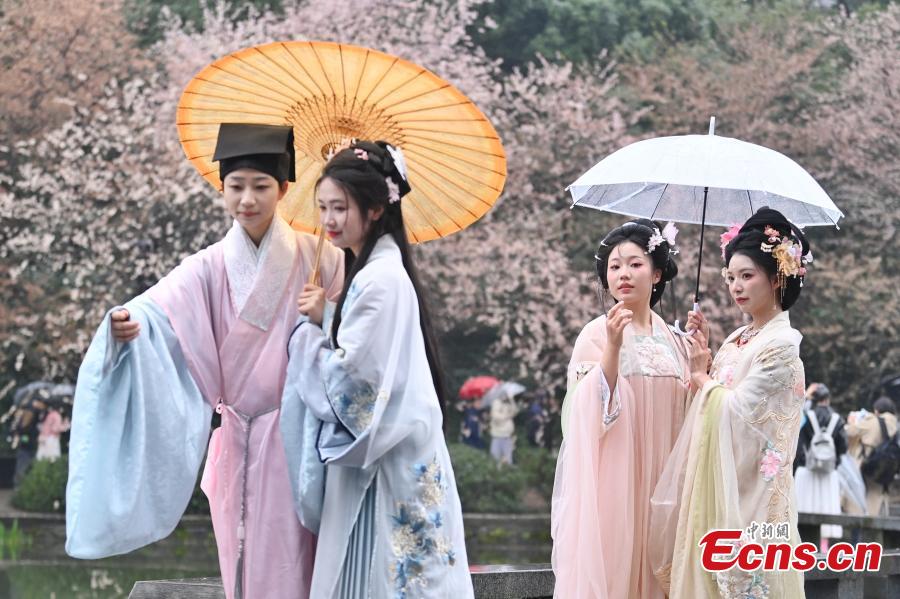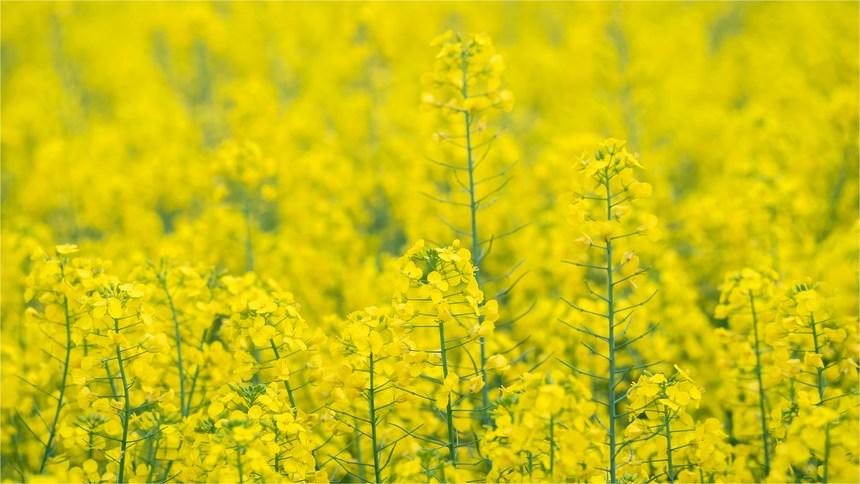Wearing traditional Chinese clothing while visiting scenic spots becomes a hit with young people
Wearing traditional Chinese clothing while visiting scenic spots has become a popular activity among young people in China in recent years.
Passengers dressed in traditional Chinese attire could ride the subway for free for about one week in Suzhou city, east China's Jiangsu Province during this year's Spring Festival holiday. As a result, the horse-faced skirt, or mamianqun in Chinese, which is a type of Hanfu, a style of clothing traditionally worn by the Han people, became a hit among young people during the holiday.

Visitors in Hanfu (a traditional Chinese costume) pose for a photo amid cherry blossoms at the Wangyue park in Changsha, central China's Hunan Province, March 17, 2024. (Photo: China News Service/Yang Huafeng)
Zhao Xi (pseudonym) is a 27-year-old Hanfu enthusiast. Dressed in traditional Chinese attire, she traveled to Chengdu, capital of southwest China's Sichuan Province last year. She found that young people clad in traditional Chinese clothing were everywhere in tourist attractions, including the Chengdu Wuhou Shrine.
"People used to think that wearing traditional Chinese clothing while walking down a street was strange. But now, people are getting used to seeing passers-by in traditional attire," Zhao said.
"People born in the 1990s and 2000s like to wear traditional clothing when traveling because they have realized that their cultural identity is related to Hanfu and it has become a fashion," said Pan Lusheng, chairman of the Chinese Folk Literature and Art Association.
"It is a spontaneous trend and demonstrates the resurgence of traditional culture," Pan added.
Chen Chen from central China's Hunan Province has collected many traditional Chinese outfits in various styles. She selects different traditional clothes according to the scenery of the scenic spots for each trip.
When buying traditional attire, Chen also pays attention to the embroidery patterns and their cultural value, in addition to color matching and style.
Wearing traditional attire is not just for taking pretty pictures, but also for gaining a deeper understanding of the cultural connotation behind the clothing and the feeling of ancient Chinese poems and essays in an immersive way, Chen said.
Bi Hong is an embroidery artist and a master of arts and crafts in Beijing who has been dedicated to traditional clothing research, protection and innovative development for nearly 28 years.
Bi's studio houses an old camphor wood box full of court costumes and embroidery works from the Qing Dynasty (1644-1911) that she has meticulously collected for over more than 20 years. She knows all about the year, materials, and color matching of each piece of her collected works, as well as the symbolic meaning behind the embroidery patterns.
From Bi's perspective, traditional Chinese attire reflects the unique cultural background, aesthetics and exquisite craftsmanship of her ancestors.
The embroidery patterns on the traditional clothes hide the words of people from ancient times. For example, the chrysanthemum pattern implies a long life and a peaceful residence.
Traditional Chinese clothing is an integral part of China's excellent traditional culture, Bi said.
“Since ancient times, China has been a nation whose people value etiquette highly and a country known for its attire. Clothing records the evolution of aesthetic characteristics across different historical periods and is one of the manifestations of Chinese civilization and etiquette," Bi added.
Bi believes that the popularity of traditional Chinese costumes will continue to grow. Additionally, she hopes that more enthusiasts will devote themselves to the protection, inheritance and innovative development of traditional Chinese attire through learning, research and practice.
Photos
Related Stories
- Hanfu beauty shines at cherry blossom festival
- Hanfu enthusiasts demonstrate traditional Huazhao Festival ceremony in U.S.
- Hanfu enthusiasts display Hanfu in London, Britain
- Feature: Hanfu show enriches Spring Festival celebrations in Malta
- Travel back in time and explore the beauty of Hanfu
- Get ready for a speed fashion show featuring Chinese traditional costumes
- Hanfu industry thrives in Caoxian county, China's Shandong
Copyright © 2024 People's Daily Online. All Rights Reserved.









